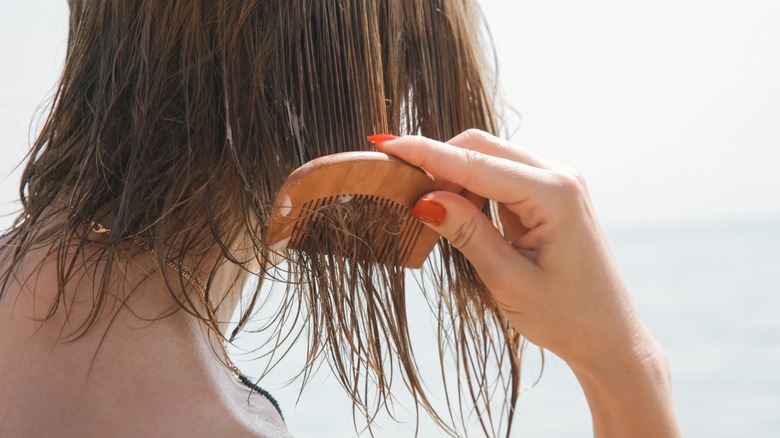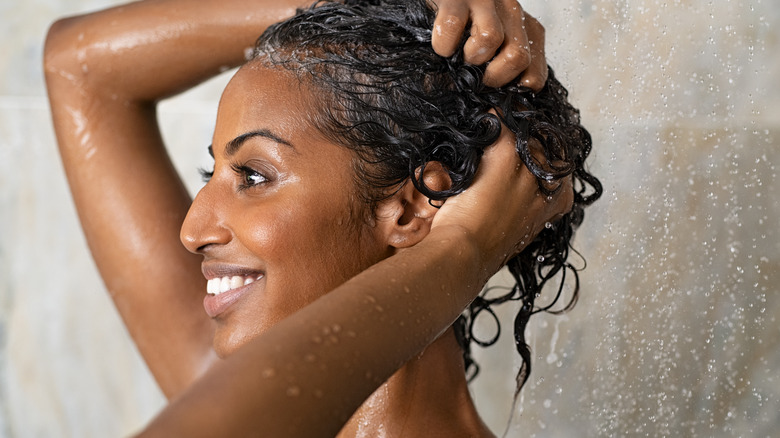How To Brush Wet Hair While Minimizing Damage
If the brutal post-shower detangling game feels all too familiar, don't worry — you're not alone. Regardless of how much conditioner was used, it always seems insufficient when it comes to getting a brush through wet hair. While it can be easy to rip through your hair as fast as possible, that's definitely not the best approach for your hair's health. Aggressive brushing, especially when there are knots in your hair, will lead to split ends and breakage.
Hair colorist George Papanikolas told Makeup by L'Oréal that hair texture actually has a significant influence on brushing techniques. While straight hair is stronger and less susceptible to damage when it's dry, curly hair is actually best brushed wet, since brushing dry curls can lead to frizz. Depending on the texture, curls can also be more fragile when they're dry. While detangling curls can vary in difficulty based on thickness and curl shape, it is generally a much more manageable task when the curls are wet.
It's important to note that brushing your hair, whether straight or curly, should not be a painful endeavor. Usually, if your hair hurts after brushing, it means you were too aggressive with your tangles and knots, which won't just feel uncomfortable but will lead to broken and damaged strands. According to SkinKraft, too much brushing can also irritate your scalp. So, while regular brushing is important for root stimulation and growth, there's no need to be excessive.
Prepping your wet hair
When it comes to brushing wet hair, Makeup by L'Oréal also notes a few key steps to have in mind in order to keep it healthy and strong. First, use the shower to your advantage. If you have long hair, you may be used to putting it all up on the top of your head while shampooing and swirling it around so that the shampoo covers every strand. However, this is an easy way to create more tangles in your hair. Instead, it's recommended to just shampoo your roots first and then gently drag the product down to the bottom of your hair. That way, once you're out of the shower and ready to brush, your hair isn't filled with tangles.
Garnier also talks about how helpful it can be to let your hair dry naturally, even if it's just for 10 minutes after showering. Using a towel to absorb excess water before brushing is also recommended. While these alone can make your hair less at risk of damage, it's also important to be patient. Instead of rushing to brush through tangled hair, first, use your fingers to separate any knots you can feel. Taking time to properly prep your wet hair for brushing will only benefit it.
Products are your friend
Whether you learn how to make your own leave-in conditioner or buy a detangling spray to use after your shower, finding the right products to use on your wet hair can truly change your beauty routine. If you often feel frustrated with your hair or struggle to remain calm amidst a knotted mess, hair products will be your new best friend. While there are many pre-shampoo hacks that you can do for healthier hair, Healthline recommends using a "pre-poo" hair mask in order to give your hair some protection, since shampoo can cause hair to lose moisture. Adding in that extra hydration will not only make your hair softer and easier to detangle, but it can make your conditioner more effective, leading to less breakage when brushing.
Looking into various types of brushes can also help to ensure that you are using the best option for your hair type. There are some brushes specifically designed for wet hair because they have thin bristles that are long and flexible. Another great option for detangling wet hair is a wide-tooth comb since it can be used to get knots out without much resistance. Byrdie also notes that focusing on the tangles at the bottom of your hair first, and then working your way up to the root with your brush is the best approach. Dividing wet hair into sections can also be a good way of working through it.
The goal is to simply take your time. Much of the damage occurs when you brush your hair in a rush. Planning your hair wash days can help you ensure that your hair gets the love and care it needs.


